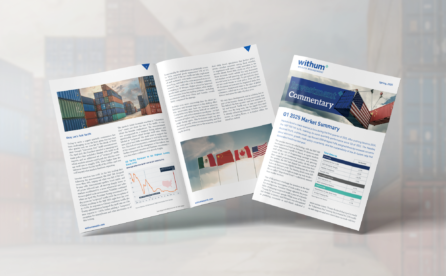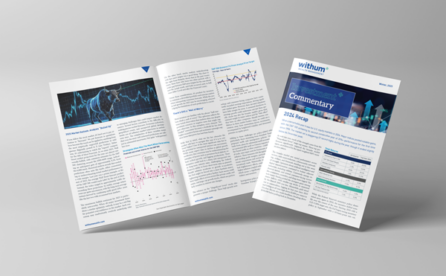
The Quarter in Review: Off to a good start
Developed equity markets around the globe moved higher to start the New Year, with U.S. stock markets enjoying particularly strong performance and reaching new highs. On March 5th, the Dow Jones Industrial Average index surpassed its previous record close of 14,165, last seen on October 9th, 2007, and continued its ascent with a series of record breaking sessions. The S&P 500 index also reached a new all-time high, surpassing its pre-crisis level of 1,565 on the last trading day of the first quarter. All told, it was quite a start for stock markets around the world with the S&P 500 index gaining 10.6% and the MSCI World ex- US index increasing by 4.8% during the first three months of 2013.
US Economy: Jobs growth may be slowing
Uncertainty surrounding the “fiscal cliff” dampened economic activity in the final months of 2012. This was evident in 4th quarter GDP data, which showed the economy expanded by a meager 0.4% during that period. The labor markets were clearly impacted as the unemployment rate ticked higher to 7.9%. With some uncertainty removed by Congress’ last-second resolution on tax rates, employers apparently became comfortable enough to begin hiring more workers. The February jobs report showed payrolls increased by 336,000 and the unemployment rate decreased to 7.7%, which was much better than most economists expected. In March, the unemployment rate dropped to 7.6% but this was largely attributable to a decline in the participation rate, and therefore should not be viewed favorably. While improvement in the job market has been positive, growth in payrolls may be losing momentum which would be cause for concern.
The housing market continues to show signs of a broadening recovery. The latest S&P Case-Shiller Index of home prices grew by 8% year over year. If broad based improvements in the housing market and the labor markets continue, consumer and business confidence should continue to rise which would have positive implications for the overall economy and equity markets.
Also worth noting is the recent pick-up in mergers and acquisitions. Merger and acquisition activity took off during the first quarter, with several “super deals” being announced early in the year. Dell partnered with private equity firm Silver Lake to announce a $24 billion leveraged buyout to take the computer company private – though successful completion of the deal remains in doubt. A couple more deals followed suit, like the $23.3 billion take-over of Virgin Media by Liberty Global, the $23 billion acquisition of Heinz by Warren Buffet and Brazilian company 3G Capital, and $11b merger of American Airlines and US Airways. According to Dealogic, there has been $219 billion spent in mergers and acquisitions so far this year. In our view, this merger activity does not represent a concern as it has been lead by a host of smart, strategic buyers and, despite relatively inexpensive borrowing costs, deals are occurring at reasonable prices. Should deals become overvalued or mispriced in the future we would re-evaluate our position on equities.
International: Foreign Economies Muddle Through
On the European front, the tiny island nation of Cyprus emerged as the newest recipient of bailout funds. While Cyprus’ economy represents a minuscule portion of Europe’s GDP (0.2%), it highlights the still fragile nature of the European Banking system. What also stands out from Cyprus’ situation is the fact that the Troika (the European commission, the IMF and the European Central Bank) demanded a tax on bank deposits above €100,000 in order to disburse the funds. This stipulation shook confidence in the European banking system, causing concern that it could set a precedent for how the European Union may deal with other economies in trouble. Overall, the Eurozone continues to move slowly towards fiscal and monetary integration.
Emerging economies as a group have not participated in the global stock market rally this year. The feared “hard landing” in China did not materialize and while still erratic, growth will likely stabilize at around 7% to 8% for this year. On the other hand, fears of a property bubble continue to take hold, as evidenced by China’s latest move to curb the property market by instituting a 20% tax on property sales. On the other side of the globe, economic growth in Brazil and the performance of its equity markets have been disappointing. It is our belief the massive infrastructure spending taking place in preparation for the World Cup and the Olympics should act as a catalyst to boost growth rates in the coming months. While emerging market concerns remain, we view the balance between risk and reward attractive for long-term investors.
The US Political Landscape: Budget Battle at its Peak
On March 1st, the $85B in spending cuts known as sequestration took place. The effects of deep across the board spending cuts should not be felt immediately, but will become more evident during the second quarter and as the year progresses.
Also during March, Congress approved a “continuing resolution” that allows the federal government to continue operating until September 30th. While we view this as a short term positive, we believe the debt ceiling negotiations that need to take place in May will be of a more contentious nature. Both the House and the Senate have passed budgets for the current year but the differences between the two are significant and, not surprisingly, there seems to be very little room for compromise since each political party stands firm in their positions. While these negotiations continue, and we await a budget with the potential to make a significant dent in our national deficit, we remain on an unsustainable fiscal path.
A Look Ahead: Liquidity Fueled Rally Could Continue
Tensions in the Middle East (Syria), threats from North Korea, and the recent acts of terror in Boston are obvious concerns to us as investors. However, record low interest rates, improving auto and housing sectors, and the accommodative stance of central banks around the world cannot be ignored.
Massive amounts of liquidity continue to be pumped into the global monetary system (i.e. Japan being the latest example of aggressive monetary policy). As long as these policies stay in place, some analysts believe equities will continue to be driven by what research firm Strategas Partners has dubbed the “TINA” factor – There Is No Alternative.
We believe, even with markets at record highs, global market valuations look attractive, and in particular, we continue to favor high quality, dividend-paying stocks. We remain encouraged by the collective actions of Corporate America and their ability to increase shareholder value. The number of S&P 500 companies issuing dividends to shareholders has reached a 14-year high and we expect dividend payouts to increase overtime.
We thank you for your continued support and, as always, we welcome your questions and comments.
This quarterly letter was brought to you by the financial advisors at PWM Advisory Group – Private Wealth Management
This article was designed for educational purposes only and is not intended for specific legal, accounting, investment, income tax or other professional advice. Please remember that past performance may not be indicative of future results. Different types of investments involve varying degrees of risk, and there can be no assurance that the future performance of any specific investment, investment strategy, or product (including the investments and/or investment strategies recommended or undertaken by PWM Advisory Group, LLC [“PWM”]), or any non-investment related content, made reference to directly or indirectly in the presented material(s) will be profitable, equal any corresponding indicated historical performance level(s), be suitable for your portfolio or individual situation, or prove successful. Due to various factors, including changing market conditions and/or applicable laws, the content may no longer be reflective of current opinions or positions. Moreover, you should not assume that any discussion or information contained in this presentation serves as the receipt of, or as a substitute for, personalized investment advice from PWM. To the extent that a reader has any questions regarding the applicability of any specific issue discussed above to his/her individual situation, he/she is encouraged to consult with the professional advisor of his/her choosing. PWM is neither a law firm nor a certified public accounting firm and no portion of the presented material(s) should be construed as legal, accounting or consulting advice. A copy of the PWM’s current written disclosure statement discussing our advisory services and fees is available for review upon request. To ensure compliance with U.S. Treasury rules, unless expressly stated otherwise, any U.S. tax advice contained in this communication (including attachments) is not intended or written to be used, and cannot be used, by the recipient for the purpose of avoiding penalties that may be imposed under the Internal Revenue Code. Photo Credit: Petur
If You Liked This Article, SHARE IT!
Help Us Spread The Word. Share This Article With Your Friends & Peers


